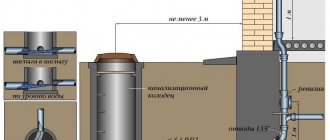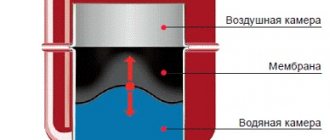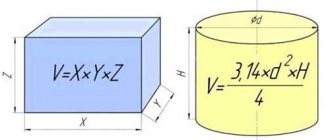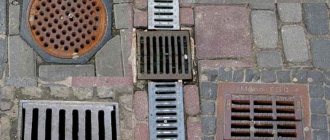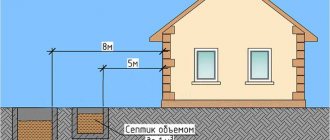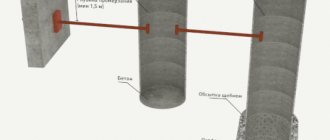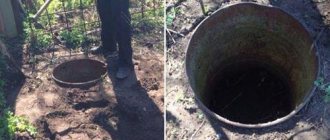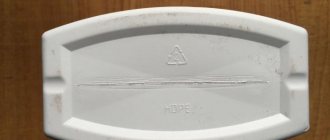Design features
A drainage pit, also known as a cesspool, is the oldest method of collecting household waste. They simply dug it into the ground, dug a trench into it and poured everything that came out of the house into it. Until recently, summer residents still used such structures. Some, in order to increase the safety of contamination of nature, lined the pits with bricks or concrete blocks.
But the essence of the cesspool has not changed. And her tasks include:
- sewage collection;
- their partial processing due to the activity of bacteria that devour organic matter;
- absorption of part of the clarified purified water by the soil;
- and everything that remains must be periodically somehow removed so that the pit does not overfill and continues to work.
As for the absorption of purified water by soil, today this approach has been slightly changed. That is, building structures are not always built in which there is no bottom or holes are left in the walls. If the groundwater level is high, then sealed structures are built so as not to affect the quality of groundwater, which is often used to organize a water supply system.
Plastic container as a cesspool Source blogremonta.com
Currently, manufacturers of plastic products offer sealed containers that are used for cesspools. These tanks are presented in a huge range on the market in terms of not only sizes, but also shapes. That is, choosing something necessary will not be a problem. At the same time, we must pay tribute to the fact that the containers themselves are inexpensive products. They are lightweight, so there will be no problems with installation.
But, as practice shows, today cesspools in private houses, which were built from ordinary building materials: brick, stone, blocks, reinforced concrete rings and even from car tires, have not yet gone into oblivion. The main task is to correctly calculate the volume, find the optimal location and build the facility taking into account regulatory requirements.
So, let's look at everything in order.
Brick drainage pit Source www.remontnik.ru
What determines the cost of digging a hole?
Excavation work has quite a lot of nuances that can seriously raise the price tag. In order not to go broke at this stage, it is worth familiarizing yourself with them at least in general terms:
- Soil type - if there is dense clay underneath your site, this will most likely increase the cost of the work. And if there are some rocks there, it will not just increase, but significantly.
- The need for special equipment - if the soil is particularly hard, or the site is located at some unusual angle, then you have to bring in special equipment, the rental of which costs a lot.
- Work time - since we are talking about country houses, if the issue cannot be resolved in a day, then something will have to be done about the workers’ accommodation. If there is space in the house, then good, but if not, the workers will bring a change house, the rent of which will be paid by the customer.
- The size and depth of the hole - the cost of the excavation work itself is calculated in cubic meters of excavated soil. The more it is, the correspondingly more expensive.
- Removal of soil - sometimes it may be that in the near future there is no need to bury the hole back, then you need to remove excess soil, and this is an additional cost.
In fact, it may happen that the company names one price tag, but the team of craftsmen on site is completely different, several times larger. You need to be mentally prepared for this.
Place for a cesspool
A drainage pit in a private house is the standards that determine its exact location. Eg:
- the minimum distance from the house is 5 m;
- from outbuildings – 4 m;
- from the fence – 1 m;
- from a well or borehole – 30 m;
- from trees - 2 m.
If the terrain on the site is uneven, then there is no need to install a drainage hole in the lowest place. In the spring, when the snow begins to melt en masse, the hole will simply be flooded with water. And its presence will be useless. Plus, the soil around the sewerage structure will be contaminated.
Cesspool location diagram Source sovet-ingenera.com
See also: Catalog of one-story house projects
Drain pit - main information
This is a simple structure that is used to collect and accumulate local sewage waste. It is into the drainage pit that waste from bathrooms, kitchen sinks, washing or dishwashing equipment is delivered through pipes. There are no treatment facilities in its design.
Depending on the degree of filling, the pit is cleaned by pumping out accumulated waste. Depending on the cleaning method, sewage is removed by sewage trucks or, after treatment with special biological preparations, used for irrigation or as fertilizer.
Volume calculation
An important characteristic for a cesspool is its volume. Of course, the larger this parameter, the less often you will have to pump out sewage waste. But this is not always permissible, especially when the area is small. Therefore, a preliminary calculation of the minimum volume is carried out. This requires three indicators:
- the number of people permanently residing in the house;
- the amount of water consumed per day per person is constant and equal to 200 l or 0.2 m³;
- this is the number “3”, also a constant number, which characterizes the number of days during which organic matter is processed by bacteria.
For example, if 4 people live in a house, then the minimum volume of the cesspool should be: 4x0.2x3=2.4 m³. Please note that this is the volume of a cesspool for a permanent residence. Guests are not counted here. Many summer residents and residents of country houses who have experience in operating cesspools argue that the volume of the structure should be a multiple of the volume of the barrel of the sewage disposal machine. This way you can simply save on calling a car, the price is .
A free access road must be organized to the drainage pit Source krd-bio.ru
Attention! If a sewage disposal truck is called to clean the pit, then it is necessary to organize an access road for it. But it’s easier to build a hole near the fence on the side of the road so that the machine’s hoses can reach it.
Principles of design and preparation of waste pits
A carefully designed project and competent planning will help to avoid problems during the construction process in terms of existing norms and regulations. First of all, attention should be paid to the most important points:
- Safe location in terms of sanitary requirements.
- The choice of system type depends on the specifics of the site and housing construction.
- Determine the dimensions of the recess.
- Plan the technology of work in advance.
- Prepare appropriate materials.
Each of the items in the list has its own nuances, the implementation of which is very important for safe and reliable operation.
- The place where the structure will be located must be remote from fences, residential buildings, and wells. From a reservoir with drinking water, for example, the distance is maintained at least 25 meters , and from the house - starting from 5 meters.
- If there are existing relief irregularities, placement in the lower part of the site should be avoided. Flooding during periods of heavy rains and melting snow threatens contamination of the soil and groundwater. Construction technology is selected based on the characteristics of the soil in the surrounding area.
- Dimensions are primarily calculated taking into account the number of residents. The planned daily volume per person is 0.5-2.0 cubic meters. m of waste . The need to pay for each call of equipment used to pump out a cesspool after it is filled requires adhering to one more rule - making the volume of the structure a multiple of the capacity of the sewer truck.
- The problem of drainage drainage is solved using perpetual cesspool technology. The design feature of this method is the construction of two containers connected to each other by a special pipe at a certain slope. After filling the first reservoir, the liquid flows into the second . This technique allows you to significantly increase the area of soil for water drainage, and only large fractions and feces will accumulate in the main pit.
- A do-it-yourself cesspool of a sealed design is a recess with a concreted bottom. The main advantage of such a device is complete isolation of sewage and the absence of any odors on the site and in the house itself. But a relative disadvantage is fast filling and frequent pumping , especially in the presence of washing machines and dishwashers, intensive use of the bathtub and shower.
A careless approach to planning and performing installation work threatens with the following consequences:
- unpleasant “aroma” inside the building and on the site;
- freezing of residual water inside the drain pipes;
- penetration of harmful substances into the soil.
Careful execution will create a favorable and comfortable environment for living and relaxing. You only need to clean the cesspools on time and periodically monitor the condition of the system.
Let us consider in more detail the features of the construction of different types of such sewer systems.
How to clean a cesspool
The most effective and fastest option is a sewage truck. True, it does not reach all dachas, so the owners of suburban real estate organize pumping themselves. There are two options here:
- By hand, using a bucket and rope. The method is unpleasant, dirty and time-consuming.
- With the help of a fecal pump, fortunately such equipment is sold today in all construction stores. Plus, the range of pumping equipment is very wide both in terms of price and performance.
Both options for cleaning cesspools require the presence of one more element, namely a barrel or any other container into which sewage waste will be drained. After which they are taken outside the village to places for special disposal. That is, you can’t just take dirt into the forest and bury it there.
Cleaning a cesspool manually using buckets Source kolodes-kopka.ru
See also: Catalog of companies that specialize in the development and installation of sewer systems
Criteria for choosing a cesspool
So, which building should you give your preference to? Let's start with filter or sealed ones. It has already been said above that filtering models cannot be installed in areas with high groundwater levels. They also cannot be installed if:
- the soil on the site is rocky, loam or clay, because sewerage simply cannot penetrate into the soil;
- Nearby there are open reservoirs that are used for water intake or swimming.
But hermetic structures can be erected anywhere. There are no restrictions here. That’s why plastic containers are so popular today. Let's look at the method of installing a plastic barrel.
Plastic barrels for sewage Source idachi.ru
Examples of the cost of digging a hole for sewerage
In general, examples of any other excavation work will be suitable, because the principle in them is approximately the same. To dig a hole 2 meters deep, 4 meters wide and a meter long in 2 days with ordinary soil will cost at least 18,000 rubles in St. Petersburg, Moscow and their regions. In the north of the country, this cost increases significantly due to freezing of the ground.
To dig the same thing in Yakutia with the removal of soil will cost 30,000 rubles . And you need to clearly understand that we are talking only about earthworks. In addition to them, you will also need to pay for building materials, laying pipes, purchasing and installing septic tanks, and so on.
Technology for installing plastic containers under sewerage
Despite the apparent simplicity of the construction operations, installing a plastic tank is not so simple:
- A pit is dug to suit the size and shape of the container. The dimensions of the pit are 50 cm larger on each side. Digging is done manually with shovels or an excavator.
- The bottom is leveled and filled with sand, which is compacted.
- A trench is dug from the house to the pit.
- The barrel is being installed inside the pit.
- The gaps between the container and the walls are filled with sand. In this case, as the filling progresses, water is poured into the barrel. This is done so that the walls of the tank do not bend inward under the influence of sand filling, thereby reducing the volume of the drainage pit. After completion of the work, the water is pumped out and released into the garden or outside the site.
- Sewer pipes are being installed from the house to the pit.
- The pipe is connected to the tank using a double-sided coupling or a socket method.
- Bury the trench with soil.
- The upper part of the sewer plastic container is also covered with soil, leaving only a hatch with a lid on the surface.
- Install the ventilation pipe.
Installation of a plastic container under a cesspool Source kanaliza.ru
How to properly operate a cesspool
Firstly, there is no need to wait until the drainage hole in a private house is filled to the brim. That is, the sewerage structure must be emptied in advance. Secondly, over time the pit itself will silt up. That is, sludge processed by bacteria will be deposited at the bottom. It is its thickness that will cause the volume of the barrel to decrease. This means that this sludge and fatty deposits on the walls must be cleaned out during pumping.
Thirdly, the most unpleasant moment in operation is the unpleasant smell of their pit. Today this problem is being solved effectively. To do this, you just need to purchase a bag of special bacteria for cesspools. Its contents are poured into any plumbing fixture, often into the toilet, or into the pit itself. Dry bacteria come to life under the influence of water and heat and begin to eat rotting organic matter, which emits an unpleasant odor. The only drawback of using bacteria is that they do not get along with household chemicals, under the influence of which they die.
Mechanical cleaning of a cesspool Source avatars.mds.yandex.net
If bacteria cannot cope with contaminants on the walls and bottom of the container, then there is only one way out - mechanical cleaning. This is when, after pumping out the sewage, a worker descends into the pit and manually removes the dirt with brushes, scrapers and other tools. Today, the hydraulic method is often used, which uses pumping equipment that supplies water under high pressure. That is, cleaning is carried out with a stream of water. The process itself is dangerous for humans because sewage releases gas. Therefore, the employee is equipped in accordance with all labor safety requirements: a respirator, safety glasses, gloves, safety shoes and clothing.
